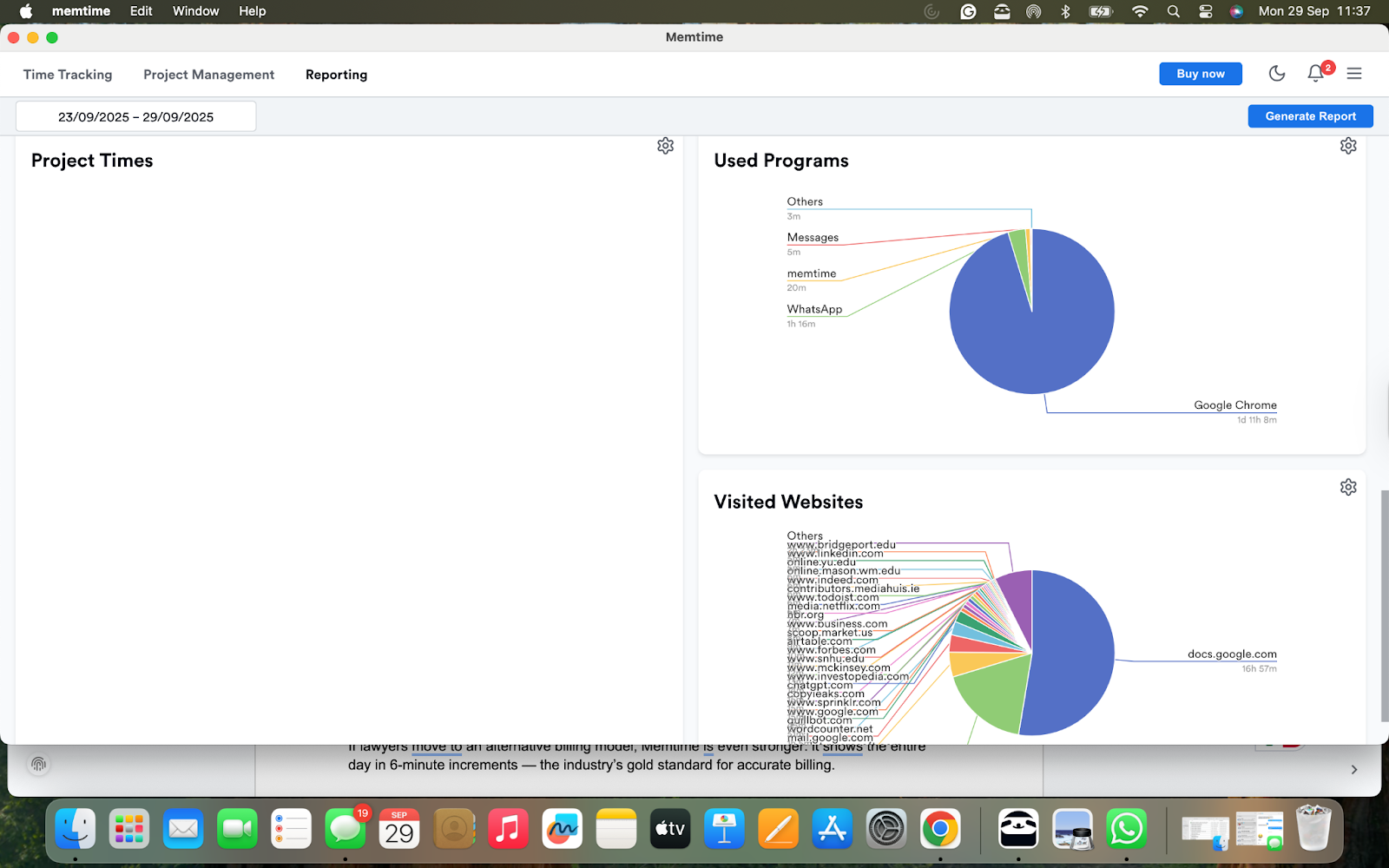Block Billing Explained: Pros, Cons, & Smarter Alternatives

In law firms, block billing is a common (though frequently criticized) timekeeping technique. For instance, attorneys combine several tasks into a single time entry rather than listing hours by task.
Although this method simplifies internal procedures for whoever is using it, it can leave clients feeling rather unhappy and largely unsure of how their money was used. Concerns about accountability, ethics, and fairness are raised by the lack of transparency.
In other words, while block billing may seem effective to legal professionals, it also raises the possibility of disagreements and harm to one's reputation.
Additionally, we'll highlight smarter, more client-friendly options that foster trust and clarity without compromising productivity. It's crucial to comprehend the ramifications of block billing, regardless of whether you're a client or a lawyer.
Key takeaways
- Attorneys can enter time more efficiently with block billing, but clients lose clarity, which makes it trickier to determine value or dispute charges.
- Uncertain billing practices can damage trust and affect referrals or retention as clients grow more cost-conscious.
- Block billing is increasingly being discouraged by courts and bar associations, which is moving businesses to switch to more transparent, task-based options.
- By showcasing accountability and value alignment, firms that implement transparent billing can differentiate themselves in client onboarding, procurement reviews, and pitching.
- Both block billing and task billing are supported by tools like Memtime, which enable businesses to export comprehensive logs or condensed reports based on client expectations and billing strategy.

What is block billing?
Block billing might be referred to as a “timekeeping technique”, but it’s essentially when several legal tasks are lumped into a single billing entry – largely without indicating the amount of time spent on each task.
This makes block billing a proverbial double-edged sword; while clients may feel shortchanged by a non-itemized bill, block billing also undervalues the true depth and complexity of the legal work performed. This makes it more difficult for customers to judge their effectiveness or applicability.
In other words, while block billing remains popular for its simplicity, it often falls short of providing the detail needed to justify costs or support a clear, mutual understanding between firms and clients:
- Clients: Lack of specificity can undermine confidence and make budget oversight more difficult.
- Firms: It can invite criticism or disagreements, especially in settings with high stakes or regulations.
Evaluating billing practices and investigating alternatives that strike a balance between operational ease, transparency, and fairness requires an understanding of how block billing works and where it fails.
Block billing in law firms – why do they use it?
Block billing is frequently used by law firms for a number of reasons. Let us count the ways:
- Efficiency: Especially for lawyers handling a large caseload, combining tasks into a single entry saves time.
- Administrative simplicity: It expedites the creation of invoices and lessens the strain of meticulous time tracking.
- Legacy systems: A lot of businesses use billing software that is based on total hours rather than task-level breakdowns.
- Strategic vagueness: To keep sensitive case details private, some attorneys favor general descriptions.
- Expedited payment cycles: Client approval and processing times may be accelerated by simpler invoices.
Although internal workflows benefit from these advantages, transparency is frequently sacrificed in the process. Understanding why companies use block billing helps explain why it continues to exist and why reform efforts are still gaining traction.
Difference between block billing vs task billing
Essentially, there are two different methods for keeping track of legal time: task billing and block billing. One prioritizes openness and specificity, while the other prioritizes speed and compatibility with legacy billing systems. Granularity, be damned! Let’s look at them a bit more.
Block billing: Once again, this method involves grouping multiple tasks into a single time entry, without specifying time per task. For instance, a simplified example of a block billing item may be:
“Drafted contract, reviewed emails, and called client – 3.5 hours”
Task billing: By contrast, this method breaks down each activity into its own time entry, clearly showing how long each task took. On an invoice, it could look like this:
- “Called client – 1 hour”
- “Reviewed and answered related emails – 30 mins”
- “Drafted contract – 2 hours”
Now, you may be thinking, “Well, isn’t this just about formatting? Don’t I get the same insight? It still took 3.5 hours!” The main distinction, however, is not whether tasks are mentioned but rather how the time is allocated and displayed.
Simply put, block billing can leave clients speculating on how that time was split (did the contract drafting, for example, take two hours or thirty minutes?) Task billing, meanwhile, increases transparency, enabling clients to identify inefficiencies and comprehend the worth of each task.
Another key distinction is how you arrive at these times. By that I mean, the compatibility with your existing systems plays a part. Task billing often requires a detailed tracking method, whereas block billing is more in line with older, legacy methods of billing.
Block billing pros and cons
For law firms, block billing provides useful benefits; otherwise, it wouldn't be a widely used technique. Ultimately, it works particularly well in high-volume settings:
Pros…
- Simplified time entry: Lawyers don't need to list every task in order to quickly log their hours.
- Continuity of operations: Adapts easily to established workflows and legacy systems. Moreover, it can lead to faster employee onboarding as junior attorneys and support teams can adopt billing practices more rapidly (that said, if you have a tool like Memtime, it does all the time tracking for you…)
- Decreased administrative burden: Similarly, you’ll spend less time on entry review and formatting.
- Maintains strategy confidentiality: Block billing can conceal sensitive information about the lawyer's work by grouping tasks together. In high-stakes situations, this can be helpful when businesses don't want to give away too much about their legal approach in a client invoice.
- Reduced client disputes over microtasks: Clients are less likely to contest charges for small tasks, like brief emails or phone conversations, when attorneys combine related work into a single entry. This can keep the billing process more efficient and prevent back and forth over insignificant details.
With these advantages come some inevitable drawbacks, however:
Cons…
- Restricted ability to audit: Task-level efficiency may be difficult for internal reviews to evaluate.
- Potential client misunderstanding: It is difficult to assess value or relevance when entries are vague.
- Possible relationship damage: Trust can be damaged by ambiguity, particularly in fee disputes or procurement reviews.
- Reputational exposure: Companies may come under investigation by watchdogs, regulators, or customers who want more openness.
- Could lead to staffing complications: In the absence of task-level detail and the time required, firms may overuse senior attorneys for routine work that could be delegated – driving up costs.
While block billing is still widely used, its long-term sustainability hinges on how well businesses strike a balance between internal convenience and external accountability.

Is block billing unethical?
Although block billing isn't inherently immoral, it can be problematic if it's used carelessly. How? Well, it can inflate charges or conceal inefficiencies by hiding the way time is allocated to tasks, particularly if clients are not specifically made aware of it.
When businesses use ambiguous entries to defend exorbitant fees or evade scrutiny, ethical risks can arise. With that in mind, many bar associations discourage the practice.
In the end, context, intent, and whether or not clients are provided with sufficient information to assess value determine its ethical standing.
Real-life examples of block billing
Block billing is still frequently used in hectic legal settings where lawyers manage several tasks at once. Typical instances include:
- Litigation: A lawyer may note, "Drafted motion to compel, conferred with opposing counsel, and revised discovery responses – 5.25 hours." Again, the overall time is obvious, but it's hard to determine how long each task took or whether drafting, negotiating, or revising (each of which has a distinct strategic weight and billing justification) took the longest.
- Procurement audits: A business client looking over invoices noticed repetitive entries such as "Case strategy meeting, legal research, and drafting memo – 5 hours," which raised questions about research being done more than once in a single day.
- Regulatory compliance: An attorney could note, "Updated internal compliance checklist, reviewed new data privacy regulations, and advised client on implications – 3.75 hours." Once again, the client cannot determine whether the majority of the time was spent on legal analysis, documentation, or direct consultation in the absence of task-specific timing.
- Petitions for family law fees: Courts frequently reject ambiguous entries in family law fee petitions, forcing lawyers to resubmit with itemized logs to support reimbursement.
Wrapping up
Memtime captures every minute automatically. When time entries are assigned to clients or matters, firms can export detailed records and then choose in their billing system whether to present them as itemized entries or combined totals.
Here are some helpful features you should know about:
- Accurate capture first: Memtime records all activity in 6-minute increments without timers or manual input — ideal for both detailed records and summarized entries.
- Transparent billing ready when you need it: As firms move away from block billing due to client pressure or regulations, Memtime already has the detailed history they’ll need.
- Program-level roundups: Memtime identifies the programs that were used during the day in our “Reporting” section. When client work centers around a single tool and you want a quick overview, this is extremely helpful.

With accurate time records, firms can avoid client disputes and prevent lost billable hours — no matter how they present invoices.
So, if you’d like to see how it can start working for you (and, by extension, your clients) today, sign up for our free 14-day trial to see all the ways it can change how you do business.
FAQs
Can court fee reductions result from block billing?
Yes. Block-billed entries in fee petitions are frequently examined by courts. Judges may reject or reduce portions of the claimed time if the descriptions are too ambiguous, necessitating a resubmission with more precise logs.
Does block billing occur more frequently in some practice areas?
Indeed, block billing is more prevalent across litigation, estate planning, and corporate law as those fields frequently require multitasking. For instance, research, drafting, and communication are usually combined into a single entry in these areas.
Are block billing requests ever made by clients?
Yes. For instance, some clients prefer simplified invoices particularly in long-term engagements. Nonetheless, a lot of people now anticipate itemized billing to assess value and guarantee budgetary compliance.
What impact do billing guidelines have on block billing?
Block billing is widely discouraged — and in many cases, courts or corporate clients will reduce or reject these invoices. For businesses to stay competitive and compliant, they must move toward these standards.
Sheena McGinley
Sheena McGinley is a columnist and features writer for the Irish press since 2008. She’s also a business owner that is conscious of how time tracking can foster progress. She wrote for SaaS companies and businesses that specialize in revenue optimization by implementing processes. She has the unique ability to digest complex topics and make them easy to understand. She shares this precious skill with Memtime readers. When she's not making words work for people, Sheena can be found taking (very) brisk dips in the Irish Sea.






